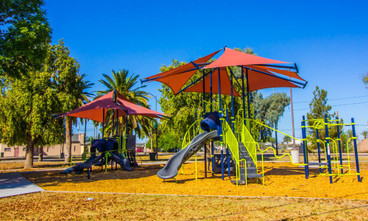Having a nice playground comes down to more than just maintaining the equipment. Cool surfaces are essential for preventing burns and other injuries.
Unfortunately, materials can heat up quickly if you don’t take the proper precautions. This guide to protecting playground surfaces in hot climates will give you all you need to ensure yours remains in top shape, no matter what.
Put Down the Proper Flooring
Hot weather can be tough on your playground’s flooring. This flooring plays a vital role in protecting children from heat and injury, which is why using the right kind for your setup is essential. There are quite a few materials available, but if you want to reduce the temperature, there are some things to remember.
Stay away from asphalt and concrete since these surfaces trap heat. Rubber, sand, and mulched wood are the best solution for maintaining a cool bottom layer. These materials also make it easier to level the playground, making it safer for play. Many playgrounds use perforated flooring to give the space some breathability.
Use Plastic Where Possible
In the past, manufacturers built playground equipment out of metal, which absorbs significant amounts of heat on hot days. Wood can also become hot and even splinter in some conditions. Instead of metal or wood, consider building your playground out of plastic.
Many plastics provide additional resistance to heat. Plastic is one of the cheapest building materials, and manufacturers can source the material from recycled products. It’s also easier to maintain and lasts longer, giving you more for your money.
Coat Metal Surfaces
While metal is an excellent building material, it can cause burns if it gets too hot, making it dangerous for children. If you must use metal on your playground, you’ll want to coat the surface with heat-resistant material that prevents it from rusting.
Although most metal equipment will come with this coating already applied, it can wear off over time, making it dangerous to use. Whether for slides, swings, or something else, it’s essential to protect all metal surfaces adequately.
Create a Border
While it might not provide any direct cooling effects, a playground border provides a boundary for your children, ensuring they stay away from hot or unsafe areas. Playground borders can significantly reduce the risk of accidents to children while outside.
In most cases, you’ll want to use a plastic or rubber border so it doesn’t get too hot and can withstand the elements without degrading. The best playset borders allow you to keep everything together in one place without cluttering your space.
Use Light Colors
Another thing to consider when trying to cool down playground surfaces is the choice of colors. When colors absorb light, they become hot, making some shades less ideal for playground equipment. Darker plastics warm up more quickly since they constantly soak the sun.
Using lighter-colored building materials will reflect rather than absorb the heat, allowing you to keep things cool on hot days. Opt for light blues, greens, and purples that will stand out while reducing the overall temperature of the area.
Use Trees and Other Natural Structures
If you can choose the playground’s location, you should take advantage of the natural foliage to shade the area. Trees, branches, and leaves make the perfect natural barrier, allowing you to avoid the sun without much effort.
If you have enough space, you might even consider planting a few near the playground. Large trees such as willows, oaks, and maples are the best for shade. You can also use hedges, shrubs, and other small plants to improve heat absorption. Depending on your region, you might even be able to add some unique species for additional visual flair.
Build Shading Structures
If there is no natural shade, consider building your own. Many modern playgrounds employ basic shading techniques to protect kids from the sun while they play. These types of equipment come in all shapes and sizes, making them excellent for all sorts of outdoor installations.
Using canopies for slides, swings, and other equipment to block UV rays shields children from the worst the sun offers. Creating a covered play area can dramatically reduce the temperature. The best part of shading structures is that you have complete control over where they go and how you use them.
Consider Ventilation
Where you build the playground can make all the difference. Both temperature and humidity play a significant role in how a playground feels. Moving air reduces heat and makes the air more breathable. It can also remove impurities and improve health.
Finding a place with good ventilation will ensure everyone is comfortable and helps the equipment last. Poor air quality can also invite insects, which can bite playing families and damage structures. Avoid areas near stagnant water or without airflow to ensure the site is safe.
Account for the Sun’s Angle
The sun moves throughout the day, making protecting the playground from the hottest temperatures difficult. However, by considering when the sun will be at its highest point, you’ll be able to build in a way that efficiently reduces the temperature. Try to position structures and shades in such a way that protects the playground from the sun’s position during the hottest part of the day.
Repair Equipment Regularly
Most modern playground equipment should prevent children from encountering hot surfaces. Older equipment can degrade and become dangerous if it isn’t adequately cared for and lacks the necessary heat protection properties.
Regularly inspecting and replacing broken equipment will allow you to keep things up-to-date without worrying about additional heating issues. If repairs are necessary, consider using the opportunity to make upgrades and improve the overall feel of the space.
Keep Your Playground Safe in Any Weather
Protecting your playground from the elements is essential, but it’s not just the heat that can destroy your playground surface. Cold, moisture, and extreme weather are constantly eroding your turf and equipment, making it harder to maintain. Ensure your equipment can withstand all kinds of weather in your region.
Having a comfortable place to play on hot days is great for children of all ages. With this guide to protecting playground surfaces in hot climates, you’ll have a solid place to start.


